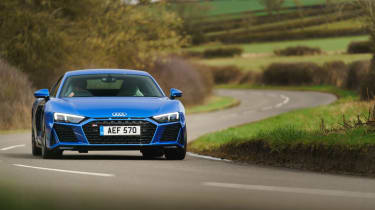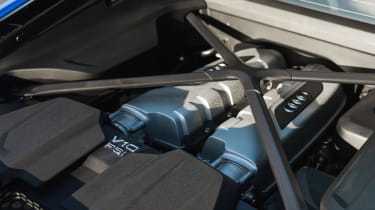Audi R8 review – engine, gearbox and tech specs
A single 5.2-litre V10 engine is the jewel in the R8’s crown, perfectly matched to a slick dual-clutch box
The physical and metaphorical heart of the R8 – the naturally aspirated 5.2-litre V10, served throughout the car’s life. As such there really are no duds powertrain wise, where the R8 is concerned – all are possessed of that glorious ten-piece orchestra mounted just behind your left shoulder.
While the first cars packed 533bhp (R8 V10) and 602bhp (V10 Plus) some rummaging around in the ECU liberated the extra 10bhp for the 611bhp the R8 V10 Performance and GT RWD enjoyed. The R8 RWD Performance received a mild uplift to 562bhp
While the earlier cars delivered peak power at 8250rpm, the potency of the later cars could be enjoyed with more headroom, with maximum power arriving at 8000rpm before the limiter steps in at 8700rpm. Peak torque ranged from 398lb ft in the lowest-spec R8 V10 of 2015 and RWD of 2020, up to 428lb ft in the very last R8 V10 Performance. All second-gen R8s deliver that peak at 6500rpm. The GT RWD served up 417lb ft, but the slight reduction in twist was mitigated by shorter gearing.
No duds extends to the transmission, a seven-speed S-tronic dual-clutch that’s also shared by all R8s, albeit as above, with shortened gearing in the R8 GT. The main let down is how you access those gears, with plastic lugs mounted to the wheel that are shared with a whole host of other VAG cars. They mire the exotic experience considerably, feeling small and cheap. Happily, the GT RWD gets slightly larger items. The gearbox itself is excellent, though. Slick-shifting, obedient, responsive. The singing V10 is putty in your palms thanks to this ‘box. Then, when you want to relinquish control and leave it to its own devices. it’ll mooch with the best of them, shifting up early and smoothly.
The brand’s four-wheel-drive system is effectively a back-to-front Haldex set-up. It can vary torque to suit conditions, even sending plenty to the back axle for some lairy corner exit entertainment if that’s your thing.
More reviews
Group tests
- Aston Martin Vantage vs Audi R8 V10 RWD – back to basics
- Audi R8 RWS vs BMW M4 CS - Audi's mould-breaking supercar takes on BMW's driving hero
In-depth reviews
Reviews
- Audi R8 V8 (2007 - 2015) review – the Porsche 911’s equal is a bargain super sports car
- Audi R8 Spyder (2016 - 2024) review – that V10 in surround sound
- Audi R8 V10 RWD and R8 RWD Performance (2020 - 2024) review – Audi's 911 GT3 fighters
- Audi R8 V10 GT RWD (2022 - 2024) review – the R8 bows out in spectacular style
All R8s are underpinned by the Audi Space Frame (ASF) structure that utilises strategic bits of carbon within the largely aluminium construction. Off this hangs the familiar double wishbone suspension, with magnetorheological dampers optional on all but the top-spec Performance Carbon Black and GT RWD. In tandem with the latter's more aggressive aero step, standard carbon ceramic brakes and lightweight forged wheels, the GT is available with adjustable coilover suspension that can be manually tuned for ride height, compression and rebound. Lightweight measures – including a carbonfibre reinforced plastic plastic front anti-roll bar and new front suspension coupling rods – contribute to a 25kg saving over the standard RWD model.
On the base car, the electro mechanical and optional dynamic steering set-ups were sped up for the updated R8 in 2018. The dynamic setup especially received strong criticism and was extensively recalibrated. Interestingly, when you put the car in its Performance mode (there’s also Auto, Efficiency, Dynamic, Individual and a unique Torque Rear program in the GT RWD) it locks the rack into its quickest setting. A Michelin Cup 2 tyre was made available for the R8 V10 Performance – standard rubber was Pilot Super Sport 4 S. Developed specifically for the R8, the extra-sticky rubber required a subtle remap of the ESP, as much to take account of the extra braking performance as for any increase in lateral grip.
The carbon-ceramic front brake discs of the updated car jumped to 380mm (standard cast iron items measure 365mm, while the rear diameter remains 356mm regardless of material) and save just over 15kg of unsprung mass. The R8 also gained the option of an aluminium carbon-reinforced front anti-roll bar that shaved a further 2kg off the overall weight – although it was no stiffer than the standard steel item.




